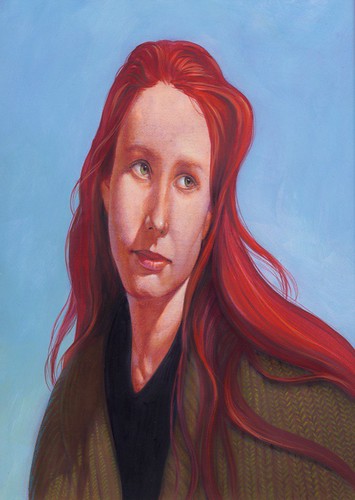
This is an homage to two illustrators whose work I have admired for decades; Gilbert Stone who made the distorted portrait famous, and C.F. Payne who perfected the mixed-media layering technique that I used for this piece. Payne also distorts his figures from time to time and pays homage to Gil Stone as he does so. Of course, stretching the figure isn't a modern phenomenon, and these guys' work is an homage to the Renaissance masters like Boticelli and the Mannerists who idealized the human form by distorting the proportions to create a more idealized figure.
This was done as a technique demo for one of my illustration classes, and the model is a student of mine named Jill.
6 comments:
wow. i love the way you handled the lighting on her face.
Beautiful!!! I wish I could stretch my figure!
Very cool!
Your work is beautiful. What medium is your work done in?
Thanks for the kind words, everyone.
This particular piece is an odd technique that goes against what most of us have been taught about mixing media. I do this technique on Strathmore 500 series heavyweight medium surface illustration board (240-11 is the product number).
The artwork begins as a graphite drawing with enough tone to begin to see the form. That layer is fixed with workable fixative. The next step is to paint in the lightest local colors with acrylics. I also usually paint on a sealer coat of matte medium and water at this stage.
Next is a layer of watercolors in the middle values. A sable brush and very clean water is used to wet areas of the watercolor and then, using a paper towel, the watercolor is "lifted" to reveal the lighter acrylic layer below. Care must be taken to only wet the areas that are the lighter values; once those areas are lifted, the form becomes clear.
The next step is the scary one; a thin wash of oils is brushed over the entire painting. The wash consists of dioxazine purple, permanent green light (to subdue the brilliance of the purple)and mineral spirits (not Turpenoid or any other gummy solvent will work, and DO NOT add Liquin to this wash).
Once the wash has had a few minutes to set up, usually a half hour or so, you take a kneaded eraser and lift out the lights once again. The purplish wash remains as the shadow tone.
After the oil wash has dried several hours, you can fix the piece with spray fixative and work into it with acrylics, inks, oils, and/or colored pencils to refine the details.
I have the directions to this technique from when CF payne visited my art school. It's really cool, and you piece is a great illustration too!
Post a Comment